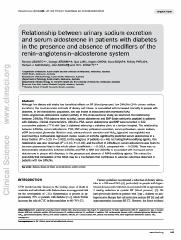Please use this identifier to cite or link to this item:
https://ahro.austin.org.au/austinjspui/handle/1/11819| Title: | Relationship between urinary sodium excretion and serum aldosterone in patients with diabetes in the presence and absence of modifiers of the renin-angiotensin-aldosterone system. | Austin Authors: | Libianto, Renata;Jerums, George ;Lam, Que;Chen, Angela X;Baqar, Sara;Pyrlis, Felicity ;MacIsaac, Richard J;Moran, John;Ekinci, Elif I | Affiliation: | Pathology | Issue Date: | 1-Jan-2014 | Publication information: | Clinical Science 2014; 126(2): 147-54 | Abstract: | Although low dietary salt intake has beneficial effects on BP (blood pressure), low 24hUNa (24 h urinary sodium excretion), the most accurate estimate of dietary salt intake, is associated with increased mortality in people with diabetes. In the non-diabetic population, low salt intake is associated with increased RAAS (renin-angiotensin-aldosterone system) activity. In this cross-sectional study, we examined the relationship between 24hUNa, PRA (plasma renin activity), serum aldosterone and BNP (brain natriuretic peptide) in patients with diabetes. Clinical characteristics, 24hUNa, PRA, serum aldosterone and BNP were recorded in 222 consecutive patients (77% with Type 2 diabetes) attending a diabetes clinic at a tertiary hospital. The relationship between 24hUNa, serum aldosterone, PRA, BNP, urinary potassium excretion, serum potassium, serum sodium, eGFR (estimated glomerular filtration rate), urinary albumin excretion and HbA1c (glycated haemoglobin) was examined by a multivariable regression model. Levels of 24hUNa significantly predicted serum aldosterone in a linear fashion (R²=0.20, P=0.002). In the subgroup of patients (n=46) not taking RAAS-modifying agents, this relationship was also observed (R²=0.10, P=0.03), and the effect of 24hUNa on serum aldosterone was found to be more pronounced than in the whole cohort (coefficient=-0.0014, compared with -0.0008). There was no demonstrable relationship between 24hUNa and PRA or BNP. Low 24hUNa is associated with increased serum aldosterone in people with diabetes, in the presence and absence of RAAS-modifying agents. This raises the possibility that stimulation of the RAAS may be a mechanism that contributes to adverse outcomes observed in patients with low 24hUNa. | URI: | https://ahro.austin.org.au/austinjspui/handle/1/11819 | DOI: | 10.1042/CS20130128 | Journal: | Clinical Science | URL: | https://pubmed.ncbi.nlm.nih.gov/23875766 | Type: | Journal Article | Subjects: | Aged Aldosterone.blood Angiotensin II Type 1 Receptor Blockers.therapeutic use Angiotensin-Converting Enzyme Inhibitors.therapeutic use Cross-Sectional Studies Diabetes Mellitus, Type 1.physiopathology Diabetes Mellitus, Type 2.physiopathology Diuretics.therapeutic use Female Humans Male Middle Aged Natriuretic Peptide, Brain.blood Renin.blood Renin-Angiotensin System.drug effects Sodium.urine |
| Appears in Collections: | Journal articles |
Files in This Item:
| File | Description | Size | Format | |
|---|---|---|---|---|
| 23875766.pdf | 349.04 kB | Adobe PDF |  View/Open |
Page view(s)
74
checked on Jan 13, 2025
Download(s)
132
checked on Jan 13, 2025
Google ScholarTM
Check
Items in AHRO are protected by copyright, with all rights reserved, unless otherwise indicated.
